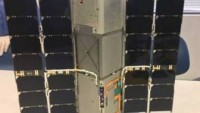China Poised to Attain 25 Successful Satellite Launches in 2016; a New National Record for a Single Year
| Arthur Dominic Villasanta | | Nov 23, 2016 04:12 PM EST |
(Photo : PLA) To be launched in December 2016: Fengyyun-4A. Jilin-1 and TanSat.
China will cap its most successful year in spaceflight in December with the launch of at least six more satellites, bringing to 25 the number of satellites orbited in 2016.
This number will be a national record for the most number of successful launches in a single calendar year.
Like Us on Facebook
China's latest success was the orbiting on Nov. 22 of the Tianlian 1-04 geosynchronous satellite, another satellite in a constellation of four that enables communications with its orbiting spacecraft and the Tiangong-2 space station.
The four satellites in the Tianlian-class of tracking and data relay satellites (TDRS) provide close to real-time communications between ground control and spacecraft. They enhance communication coverage with manned Shenzhou missions from Shenzhou 7 onwards and are indispensable in this role.
To be launched in December will be the first of six Fengyun-4A geostationary weather satellites on Dec. 11; TanSat or CarbonSat that will monitor carbon dioxide; the Jilin-1 "commercial remote sensing satellite," and three other satellites to be orbited along with Jilin-1, each with a different function.
Fungyun-4A is part of China's geostationary meteorological satellite program called Fengyun-4 (FY-4). It's the second generation of this class and will replace the earlier FY-2 series. Fengyun-4A will blast-off from the Xichang Launch Center.
The second Fengyun satellite, FY-4B, will launch in 2018 and the third, FY-4C, in 2020. No launch dates have been announced for FY-4D, FY-4E and FY-4F. The FY-4 sats have a lifespan of five years.
TanSat is the first Chinese mini-satellite dedicated to detection and monitoring of carbon dioxide (CO2). Funded by the Ministry of Science and Technology, TanSat will carry two main CO2 detection instruments.
The first is CarbonSpec, a high-resolution CO2 spectrometer for measuring the near-infrared absorption by CO2 and the second is the Cloud and Aerosol Polarimetry Imager (CAPI) to compensate CO2 measurement errors by high-resolution measurements of clouds and aerosols.
A spy satellite, Jilin-1 is a high-definition optical satellite equipped with a 0.72 meter resolution pan-chromatic camera and 4 meter resolution multi-spectral camera. It will operate as part of a constellation of four satellites.
The other three satellites in this spy satellite constellation are LQSat, which will carry an experimental imager with a ground resolution of 5 meters and Lingqiao A and B, two remote sensing video spy satellites designed to capture videos with a ground resolution of 1.3 meters.
Tagschina, Satellites, record year, 2016, Tianlian 1-04, Fengyun-4A, TanSat, Jilin-1
©2015 Chinatopix All rights reserved. Do not reproduce without permission
 China Activates World’s Longest Ultra Secure Quantum Communication Network
China Activates World’s Longest Ultra Secure Quantum Communication Network SpaceX will Dominate World Internet with Plan to Launch 4,425 Internet Satellites
SpaceX will Dominate World Internet with Plan to Launch 4,425 Internet Satellites NASA to launch Six Small Satellites that will take a Fresh Look at the Earth and its Weather
NASA to launch Six Small Satellites that will take a Fresh Look at the Earth and its Weather China Unveils First Satellite Smartphone with Coverage up to South China Sea
China Unveils First Satellite Smartphone with Coverage up to South China Sea
EDITOR'S PICKS
-

Did the Trump administration just announce plans for a trade war with ‘hostile’ China and Russia?
-

US Senate passes Taiwan travel bill slammed by China
-

As Yan Sihong’s family grieves, here are other Chinese students who went missing abroad. Some have never been found
-

Beijing blasts Western critics who ‘smear China’ with the term sharp power
-

China Envoy Seeks to Defuse Tensions With U.S. as a Trade War Brews
-

Singapore's Deputy PM Provides Bitcoin Vote of Confidence Amid China's Blanket Bans
-

China warns investors over risks in overseas virtual currency trading
-

Chinese government most trustworthy: survey
-

Kashima Antlers On Course For Back-To-Back Titles
MOST POPULAR
LATEST NEWS
Zhou Yongkang: China's Former Security Chief Sentenced to Life in Prison

China's former Chief of the Ministry of Public Security, Zhou Yongkang, has been given a life sentence after he was found guilty of abusing his office, bribery and deliberately ... Full Article
TRENDING STORY

China Pork Prices Expected to Stabilize As The Supplies Recover

Elephone P9000 Smartphone is now on Sale on Amazon India

There's a Big Chance Cliffhangers Won't Still Be Resolved When Grey's Anatomy Season 13 Returns

Supreme Court Ruled on Samsung vs Apple Dispute for Patent Infringement

Microsoft Surface Pro 5 Rumors and Release Date: What is the Latest?










